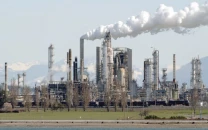G7 looking at Russian oil price cap of $65-70
Production costs are estimated at around $20 per barrel

The Group of Seven nations (G7) are looking at a price cap on Russian sea-borne oil in the range of $65-70 per barrel, a European Union (EU) diplomat said on Wednesday.
Views in the EU are split, with some pushing for a much lower price cap and other arguing for a higher one. The G7, including the United States, as well as the whole of the EU and Australia, are slated to implement the price cap on sea-borne exports of Russian oil on December 5.
“The G7 apparently is looking at a $65-70 per barrel bandwidth,” the EU diplomat said.
“Poland, Lithuania and Estonia consider this too high because they want the price set at the cost of production, while Cyprus, Greece and Malta find it too low, because of the risk of more deflagging of their vessels, which might mean the G7 has found a good middle-ground,” the diplomat said.
Some 70%-85% of Russia’s crude exports are carried by tankers rather than pipelines.
The idea of the price cap is to prohibit shipping, insurance and re-insurance companies from handling cargos of Russian crude around the globe, unless it is sold for no more than the maximum price set by the G7 and its allies.
Because the world’s key shipping and insurance firms are based in G7 countries, the price cap would make it very difficult for Moscow to sell its oil – its biggest export item accounting for some 10% of world supply – for a higher price.
At the same time, because production costs are estimated at around $20 per barrel, the cap would still make it profitable for Russia to sell its oil and in this way prevent a supply shortage on the global market.
Brent crude front-month future oil prices initially fell to $86.54 from $87.30 on the news.
Published in The Express Tribune, November 24th, 2022.
Like Business on Facebook, follow @TribuneBiz on Twitter to stay informed and join in the conversation.



















COMMENTS
Comments are moderated and generally will be posted if they are on-topic and not abusive.
For more information, please see our Comments FAQ